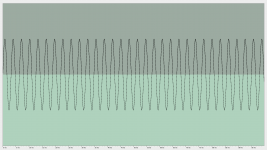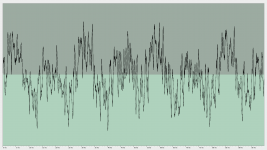An amplifier shall create an greater version of its input on its output.
If one agrees to this, measurements are the only way to prove the amps performance.
If one have other ideas of the task for an amplifier - measurements are almost meaningless as there is no target for the design and thus, nothing to evaluate measurements results towards.
Logical?
Now, position this to "experienced sound quality".
//
If one agrees to this, measurements are the only way to prove the amps performance.
If one have other ideas of the task for an amplifier - measurements are almost meaningless as there is no target for the design and thus, nothing to evaluate measurements results towards.
Logical?
Now, position this to "experienced sound quality".
//
No blame, it is just a description of function.But..... distorsion is low in amps and DACs - no?
The use of low distortion amp probably creates the lowest acoustic distortion when used with a multiway speaker. But would you call a system doing 0.5-2% THD @88 dB SPL a HiFi?
A multi amp system can perform better when used with each amp tailored to cancel the distortion of the driver it drives as much as possible. Or when the use of low distortion amps is desired then another device such as a DSP can take over the job of preconditioning the signal instead.
If one agrees that an amplifier will create a greater version of dynamic input signals on its output, time-invariant measurements are the wrong way to prove the amps performance.
So the logical way is measuring with the music rather than with time-invariant tones.
That's the target.
Moreover, if measurements are the only way to prove the amps performance someone should explain why people buys the Cyrus Mono X instead of the "second harmonic down to -130 dB!!! Pretty remarkable" Hypex NC400 (if I'm not wrong it's even cheaper).
So the logical way is measuring with the music rather than with time-invariant tones.
That's the target.
Moreover, if measurements are the only way to prove the amps performance someone should explain why people buys the Cyrus Mono X instead of the "second harmonic down to -130 dB!!! Pretty remarkable" Hypex NC400 (if I'm not wrong it's even cheaper).
Last edited:
If one agrees that an amplifier will create a greater version of dynamic input signals on its output, time-invariant measurements are the wrong way to prove the amps performance.
So the logical way is measuring with the music rather than with time-invariant tones.
That's the target.
Moreover, if measurements are the only way to prove the amps performance someone should explain why people buys the Cyrus Mono X instead of the "second harmonic down to -130 dB!!! Pretty remarkable" Hypex NC400 (if I'm not wrong it's even cheaper).
Trying not to be too rude. If you’re seriously still asking this. Because the rich are generally some of the biggest suckers out there for pseudoscience Andrea!!!
Are you blissfully unaware that the demographics actively leading the rise of anti-science movements, like say anti-vaxxers, are economically privileged?
Parents who don'''t vaccinate kids tend to be affluent, better educated, experts say - ABC News
It should come as no surprise that high end audio is full of grifters. All you can do is speak with fluff about numbers and hope that distracts the silent readers enough that they ignore the fact that you’re trying to dispute international scientific consensus about the limits of human sensory perception.
Let me ask you Andrea, what do you consider audio snake oil? Do you buy silver, gold, and palladium alloy based interconnects? What about cable lifters? Are audiophile fuses a part of every one of your components? Ooh what about the bybee products? You were oddly silent about those.
Every single one of those components has designers who can show us people who claim to hear differences, and that the tools we use to measure, not our ears, that are the weak link. So, I assume you make use of all of these, right?
If one agrees that an amplifier will create a greater version of dynamic input signals on its output, time-invariant measurements are the wrong way to prove the amps performance.
And how did have you reached this conclusion?
As for why people buy mediocre amps, that's an easy answer: basically for the same reason people are buying your amazing low phase noise clock. It is not the performance that sells an high end audio gizmo, but the story created around the product, which includes an entire marketing tactics arsenal. Everything based on the fact that buyers won't hear a damn of a difference between the Cirrus and the Hypex, unless they are told ad nauseum, by the sales force, they do.
Aligning the sales force behind an high end audio product is not easy, and it is usually driven by the sales margins allowed. That's the reason why a high end audio product costs D dollars to manufacture and at least 4xD dollars to purchase in a high end audio store, the sales force is therefore highly motivated to create and perpetrate stories of the amazing sound.
So the logical way is measuring with the music rather than with time-invariant tones.
As test signal, I will use an "approximation" of music, basically one low frequency tone of varying amplitude and offset (to set and sweep the operating point) and one high frequency tone of constant low amplitude. No FFTs, of course.
Trying not to be too rude. If you’re seriously still asking this. Because the rich are generally some of the biggest suckers out there for pseudoscience Andrea!!!
Are you blissfully unaware that the demographics actively leading the rise of anti-science movements, like say anti-vaxxers, are economically privileged?
Parents who don'''t vaccinate kids tend to be affluent, better educated, experts say - ABC News
It should come as no surprise that high end audio is full of grifters. All you can do is speak with fluff about numbers and hope that distracts the silent readers enough that they ignore the fact that you’re trying to dispute international scientific consensus about the limits of human sensory perception.
Let me ask you Andrea, what do you consider audio snake oil? Do you buy silver, gold, and palladium alloy based interconnects? What about cable lifters? Are audiophile fuses a part of every one of your components? Ooh what about the bybee products? You were oddly silent about those.
Every single one of those components has designers who can show us people who claim to hear differences, and that the tools we use to measure, not our ears, that are the weak link. So, I assume you make use of all of these, right?
I'm sorry but until a few days ago I didn't even know what bybee products were.
Having said that maybe my humble laboratory is still better equipped than yours.
I said maybe, so please let me know if I'm wrong.
This means I'm probably used to make measurements.
But this does not mean that the measurements I take are the right way to evaluate the performance of an audio device.
In fact, I don't think so.
And now please let me understand, do you think I would get more effective measurements if I replaced my humble QA401 with an AP tool?
If so let me know why.
As test signal, I will use an "approximation" of music, basically one low frequency tone of varying amplitude and offset (to disturb the amp) and one high frequency tone of constant low amplitude. No FFTs, of course.
Yes, of course, everybody and their next of kin knows FFT is an evil, misleading tool, good only to send rovers on Mars, listen to the 10E-23 watt signals coming from the Deep Space Network, and listening to gravitational waves.
And how did have you reached this conclusion?
As for why people buy mediocre amps, that's an easy answer: basically for the same reason people are buying your amazing low phase noise clock. It is not the performance that sells an high end audio gizmo, but the story created around the product, which includes an entire marketing tactics arsenal. Everything based on the fact that buyers won't hear a damn of a difference between the Cirrus and the Hypex, unless they are told ad nauseum, by the sales force, they do.
Aligning the sales force behind an high end audio product is not easy, and it is usually driven by the sales margins allowed. That's the reason why a high end audio product costs D dollars to manufacture and at least 4xD dollars to purchase in a high end audio store, the sales force is therefore highly motivated to create and perpetrate stories of the amazing sound.
My clock is really amazing low phase noise by measurements, but this time I would avoid commenting on yours.
Then my conclusion is from the real world.
Attachments
You strike me as the kind of guy that doesn’t know how a hammer works, and therefore complaining about not being good enough for his nails.
Alright, challenge accepted:
Tell me how to measure the small-signal gain at a specific frequency, at a specific operating point, of a nonlinear, non time-invariant system, using a FFT of course.
Except for the fft reservation; isn't that a clever test signal? Make it two or three tone + the low freq warble amp annoyer.
I don't think several tones will be necessary, but I will probably try it anyway.
Last edited:
Tell me how to measure the small-signal gain at a specific frequency, at a specific operating point, of a nonlinear, non time-invariant system, using a FFT of course.
No challenge here. You mentioned a hammer, now you are asking about how to use a screwdriver.
BTW, audio screws are time variant only for the high end audio sales force that want to add to their sales pitch a dash of technical mud. Except for thermal distortions (which, if audible, the gizmo belongs to the pathological designs realm) there is no other time variant component to speak about, in any audio amplifier.
As test signal, I will use an "approximation" of music, basically one low frequency tone of varying amplitude and offset (to set and sweep the operating point) and one high frequency tone of constant low amplitude. No FFTs, of course.
So why not real music?
Do you think it's not possible?
I think it's possible.
Hardware is almost clear, the real problem is developing the Windows based software (too little free time).
Except for the fft reservation; isn't that a clever test signal? Make it two or three tone + the low freq warble amp annoyer...
//
A 60Hz and a 7KHz 4:1 is the standard signal to measure IMD. About the same, minus the low frequency warbling which I don’t know what could better reveal. Multi tone signals are also used to measure IMD. Both measurements are based on interpreting the FFT spectra, first the harmonics, second the noise between the harmonic components.
- Status
- Not open for further replies.
- Home
- Member Areas
- The Lounge
- Sound Quality Vs. Measurements

